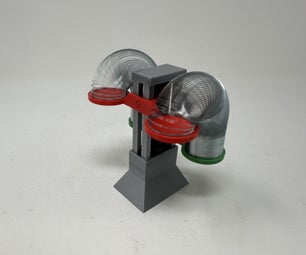Introduction: DIY Van High Top
The Idea was to find a low-mileage large van and make it into a standing-height, high-ceiling a work vehicle. I couldn't see parting with 40-50K for a sprinter van, or similar. This could also work for a camper.
The van top that the local company sells is either too high or too low, and relatively heavy and $2500+. Combine that with it's 60 miles away, so I decided to make my own.
The idea was to make a frame, cover it with .22 plywood, anchor it the van with screws, fill the voids (rear corners) with spray foam, (red cans that cost about $3 at a hardware or building supply store,) coat this with laminating resin, fiberglass over the corners and edges of this structure first with 1-1/2oz fiberglass mat, then over the entire structure with 10 oz. fiberglass cloth. Once fiberglassed, a filler was made with laminating resin, mixed with a thickening powder, called Q-Cell, to make a filler and a surfacing agent, to allow it to sand easier. The top was then insulated with 1-1/2 foam sheets, which is sold at building supply stores in 4x8 sheets, then paneled on the inside.
Step 1: Step 1 Cut the Top - Start the Frame - Panel
The video shows the cutout and frame from the inside. It's worth a look.
The top is cut behind the 1st brace and about 4" above the gutter, per instructions received from the van top vendor. The seats are in front of the first brace, so you can't really stand up there anyway. This gives support and protection to the driver and passenger. I cut it using a combination of electric sheet metal shears and a cut-off wheel. (HF 68199 and 68523)
The metal removed from the top weighed a bunch! Probably around 100 lbs.
After looking around my garage and knowing what I could do, I decided to either make a frame out of 1/4-1/8" plywood strips 1-1/2" wide glued together so I could make bends, or use some 1'1/2" .06 wall 6061-T6 aluminum tubing. The tubing was used. Bent with a tubing bender and 1-1/2" dies (JMR Sportsman or JD Squared model JD 3)
Wherever the tubing was bent, it was annealed with a propane torch, to burn off the heat treating markings and slowly bent in a hydraulic tubing bender with 1-1/2" dies. Plywood bent and glued would work just as well, as also would wooden (clear (without knots) is best) 2x2's with plywood gussets for the corners.
It just so happens that closet pole, 1-3/ 8 fits nicely inside the 1-1/2 .06 wall tubing Anywhere a piece need help (short or boo boo), I used the pole to help. An 1-1/2" hole saw, in a drill press allowed cutting the tubing to fit each other. Where the tubing met the body, the closet pole was fit to the body, then inserted into the tubing, and a sheet metal screw or two were used to lock it in.
I made the first side, then the second side, to match. I was a little off (1") and if you look close you can see it.
To hold the two sides, I made a 12" piece of panelling, cut to approx. what I wanted and screwed it in the rear, one side at a time, on this you could use a helper. After a couple of adjustments, the front and side panels were attached.
It's a good idea to step back and look at things every so often and fix weird stuff (sagging, crooked) before it gets harder to fix. Braces 2 feet on center give you good nailing spaced when you go to panel the inside.
For the roof, I bent braces to be more aerodynamic and to allow for a higher ceiling and put a place to install a roof vent or A/C.
The round corners posed an issue, but I either cut kerfs in the panelling or used spray foam to provide a rounded surface for finishing. (Fiberglass needs a 3/8 or greater radius or it bubbles.)
Attachments
Step 2: Fiberglass and Insulation
Fiberglass provides strength and waterproofing. The laminating resin makes it so you don't have to sand between coats, if it doesn't set several days, and makes it waterproof. The 1-1/2oz matt and 10oz cloth give it strength. You can buy matt and cloth sewn together, which would have probably been a better choice. It's stronger and only slightly heavier. There is an internet vender that has darn good prices, the local vendor was a twice as much.
I coated the top with laminating resin to seal and to provide a good base for the matt and cloth.
After reinforcing the edges and joints, I sanded the rough spots and installed the cloth. (eye and lung protection)
Sand the rough edges and cover in sections maybe 2x4 feet with a filler made from q-cell and laminating resin with surfacing agent and sand before it gets super hard......15-45 minutes later......with 36 grit attached to a 12-16" x 2-1/2" sanding board. (HF 91773 air powered and/or 1727) so its flat or transitioning smoothly.
LOTS of sanding. If you put white pigment in the mix before adding the q-cell thickener, you may save a little on gelcoat. Any electrical (12v and/or 120v) should be installed before the insulation. Insulation can be installed when you get tired of sanding and the inside can be paneled.
Step 3: Gel Coat and Panel
If you use a low nap 6" roller, you can roll on the gelcoat and it worked out ok. This is way easier than spraying and the masking-off needed.
After rolling on the gel coat, let it set up (20-45 minutes) and roller over it with mold release. The mold release makes the gelcoat finish shinier and washes off....I left it on a few hours, as I was instructed. over night probably would have been fine.
I then paneled the inside with .22 paneling and built some benches and shelves.
The top weighs about what the top removed weighs. It has 8 sheets of .22 paneling, very light insulation, 4 or 5 20' sections of 1-1/2 .06 aluminum tubing, 5 -8' 2x2's and various fasteners. The weight of the fiberglass and resin could be 20 lbs....so with the interior is probably weights 120 lbs. The rest of the interior weighs more, maybe double.
The van gets 15 mpg + on the freeway, 12mpg around town....It's a 1996 Dodge Maxivan with a 5.2L engine.
This actually was a pleasant surprise.
It would be really excellent to make the doors taller too, but I want to use this more and work out any kinks.
This van is a 1996 Dodge Maxivan with 85,000 from the original owner and tons of maintenance paperwork, and it had a leaky, rusty roof. As a slightly wacko Idea, I would really like to make the top a removable boat, but that's another project, another day. I'm happy with this project and have decided to do a "Sprinter" type van but need to sell this first. 11/14/18 the van is for sale, Sold 11/30/18 to an adventurer who has been all over the world, and just cam back from Africa, I hope Amanda enjoys it, as it was a fun project.














